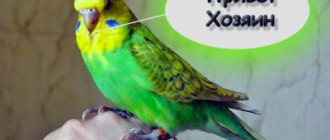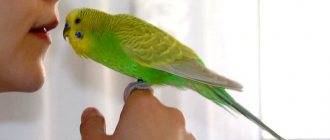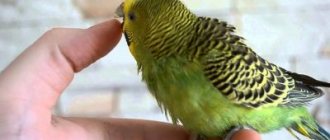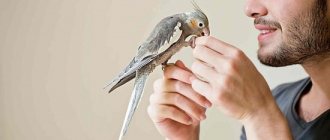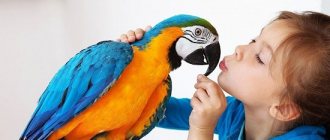Most owners of the parrot family are faced with the problem that their pets bite. Often, it is the female that can initiate a fight. But at the same time, females are considered calmer, in contrast to active males.
Why do girls bite more often, and why do they peck their partners? Let's figure it out.
Why do parrots bite?
Before answering the question why a female budgerigar bites a male, you need to understand what a bite means for birds. In nature, parrots do not bite each other. The beak is given to them not only for food, but also as an additional hand. With the help of its beak, the bird can grab onto something while climbing trees.
Resolving conflicts using their beaks is not typical for budgerigars that live in the wild. They resolve their differences through body language and voice. First of all, the newly born chick uses its beak to understand the world.
When a baby goes beyond what is permitted, an adult pet can pinch him with his beak and in this way make it clear that this should not be done.
Such bites from adult birds discipline the chick. And if a budgie grows on its own, it does not know that biting with its beak causes pain.
There are times when the owner, without knowing it, teaches the parrot to bite. This happens the moment the owner puts his hand into the bird's cage.
The chick sees this as an opportunity to get out of the enclosure and tries to grab the hand. At the same time, when the owner of the bird stretches out his hand, the pet thinks that he simply has a bad grip and next time he will try to strengthen the bite.
How many days do chicks hatch?
Parrots are responsible parents and do not leave the eggs until the chicks hatch. Most often this happens on days 15–20. The chicks are born weak, helpless and also blind. At first, the mother feeds them with crop milk and warms them with her body. They become more independent after 15 days. At this time, the eyes are already open, the paws have become stronger. The chicks can already eat the softened grain, but the parents take care of them for some time.
As you can see, determining pregnancy is quite simple; the main thing is to carefully monitor your feathered pets. It is important at this time to provide the birds with a balanced diet and good care.
Causes of bites in pairs
There is another explanation for when a winged friend begins to bite: this is a marking of its territory. In the case when a male is placed with a female parrot, the girl begins to sense a stranger in her territory and defends herself by pecking at her neighbor. In this case, it is necessary to wait until the bird gets used to the new “guest” and they develop a friendship.
Another reason for a female parrot pecking is the pet’s poor health. She wants not to be touched.
Most often, females can be irritated and peck at males who come across them due to the following factors:
- bad mood, depression;
- disease;
- fatigue.
In cases of a depressed state, the bird should be left alone, not touched for a while, and allowed to rest. At this time, it is better to move the neighbor to another cage until the female returns to good mood and vitality.
But if the pet begins to weaken, loses appetite, and you see uncharacteristic litter, then this may indicate her illness. And here a clinical examination of the pet is necessary.
Conflict between parents and children
Often fights between parrots (parents and children) can lead to murder. Therefore, it is better to prevent the problem and immediately after the birth of the offspring, place the babies in the brooder. Feed them from your own hands and keep the babies there until they fledge.
Why this happens is not fully understood. The birds may not have enough lighting, food or space. If the parents are too young, then they are not yet mentally ready for motherhood and fatherhood.
The fledgling chicks need to mature and grow up in order to be placed in the same home with their parents again. Living in one large company, adult females may begin to conflict without dividing the nest among themselves.
Jealousy
Budgerigars are very jealous birds.
The female, as well as the male, can be jealous of each other’s rivals and, in this case, peck at the partner. If you have one pair of parrots, the female may consider her owners rivals. If the wavy sees that you are spending more time (playing, petting, feeding) on another pet, then she begins to get angry and bite everyone around her.
It can peck at the owner’s hand and even at a harmless male. To prevent this from happening, you need to try to devote time to both birds at once, so that not one parrot feels deprived of attention.
Budgerigars have fairly strong beaks. If you see that your pets are starting to injure each other, then the couple is probably not working out or their behavior needs to be adjusted.
Cage equipment for pair housing
If you decide that the spark between your wavy birds has grown into a flame of love, then you can start equipping the cage with matching accessories.
The cage must have:
- two perches on the upper level and two perches on the lower level;
- two feeders and two drinkers;
- two feeders for wet food or treats;
- two swings. Sometimes owners successfully replace this with a two-seater swing and the birds do not have any conflicts;
- All toys must be in duplicate.
Sometimes it happens that a more shy individual takes less comfortable places, and his other half, seeing this weakness, begins to take advantage of it over time. Or one partner becomes aggressive and hits the other.
You can watch a couple of budgies loving and caring for each other forever. This is a wonderful example of mutual respect and loyalty that you can show your children. However, much in their relationship depends on the owners themselves, how willing they are to devote time to them and provide proper care.
Parrots, like people, need communication, a friend, a soul mate. Why and what to do if suddenly the birds began to fight among themselves.
Behavior correction
Before you start to deal with the fact that a female bites a male, determine the very problem of what is happening. If your bird shows that it is jealous of its neighbor, give it more attention and care. And also point out “who’s the boss of the house.”
To do this, the winged friend is tamed and taught simple actions. A bird that trains day after day will understand that you do not claim its territory and that you are the main thing for it.
Wavys react well to the facial expression of their owner and his intonation. Therefore, if a bird behaves badly, for example, pecking at its cage neighbor, you can say in a more stern tone that this is not allowed. Therefore, train your bird to show it when you approve or disapprove of its behavior.
If a female budgerigar pecks her partner, say “no” in a stern tone and show her a negative nod of your head with your facial expressions. But under no circumstances should you yell at your pet, as it may become frightened, offended, or stop trusting you. Education and training must be continued as long as the wavy wants to communicate with you.
As soon as the bird shows its disinterest in what is happening, end the lesson. If the female parrot cannot be trained and pecks the male, place the birds. It is likely that it will take time for the parrots to rest a little from each other. Perhaps they need to rebuild their relationship.
With regular and proper training, the winged pet will lose the habit of biting, realizing that it is bad. And also, he will respond well to all commands of his owner.
Personal animosity
It happens that relationships with parrots do not work out, despite the fact that you seem to have done everything right and taken into account all possible options. There is no peace in the cage - no matter what you do. In this case, there is only one explanation - the feeling of hostility that arose between these wavy cuties. What explains it is unknown, as is the case with people in similar cases. Give them another chance: place them in different cages located nearby. Let them out of the cage at the same time - maybe the space unlimited by the cage bars will somehow help them come to an agreement and clarify their relationship. If not, you will have to keep them separate, and in the future select other partners for each.
So why does the female peck the male?
There may be several reasons why a female parrot pecks a male:
- Poor mood or health condition.
- Jealousy.
- Defense of the territory.
Before taking action, you need to determine the reason why the bird is pecking its partner. If your parrot feels uncomfortable or tired, it should be given time to rest, but this behavior should not be encouraged.
It’s not difficult to get rid of a female’s jealousy - you should pay equal attention to both birds, showing your love for birds. Help your parrots build a relationship from the very beginning, and you may not need to take any further action.
If the owner can anticipate the female’s desire to peck the male and learn to correct her behavior, he will help the parrot live a calmer and happier life.
Other rules
Unlike people, birds have different norms and rules of behavior. It is not human nature to bite. But in the world of birds, this is one of the accepted methods of communication. Sometimes, a bird can bite off another bird's toe and cause even more serious injuries to it. However, most of them cause little, if any, harm to other birds with their bites. Therefore, do not get overly upset, worrying about why the parrot bites and what to do. Remember that this is a feature of their communication. The birds have dense down and smooth plumage, which serve as a kind of protection against bites and lead to the fact that they only occur in passing. Unlike birds, humans do not have the same protection as feathers. The bite hits the skin directly, leaving scars, bruises or cuts. Bites can result in a simple scratch, or they can result in bone fracture.
About three times a year I get very strong bites. Usually it’s my fault for not following my own advice. My troupe of birds, called the Delightful Amazons, perform daily stunts that put me in quite a vulnerable position. My birds are known not only for their artistic abilities, but also for their gentle dispositions. Usually about 250 people pick them up after each performance. And in 10 years of work they have never bitten anyone. Although parrots are the best birds to bite.
One of the best ways to avoid a bite is to know what can trigger it. Understanding why a bird bites and what might trigger it to do so will help you avoid many injuries. You just need to be attentive to the bird to prevent it from biting you.
Hormonal surges
A very common occurrence among same-sex parrots (males). They can coexist peacefully from early childhood. Having reached a certain age, conflicts and bloody fights begin.
The solutions are:
- For one month it is necessary to place them in different cages;
- Give only grain mixtures, slightly reducing the daily feeding rate;
- Make daylight hours shorter by covering the boys' homes with thick fabric.
After the 30 day period has passed, connect the males again. If the fights continue, it means that hormones are taking over and they begin to fight for primacy in the cage. Only one thing will help here - to finally settle the fighters in individual housing.
